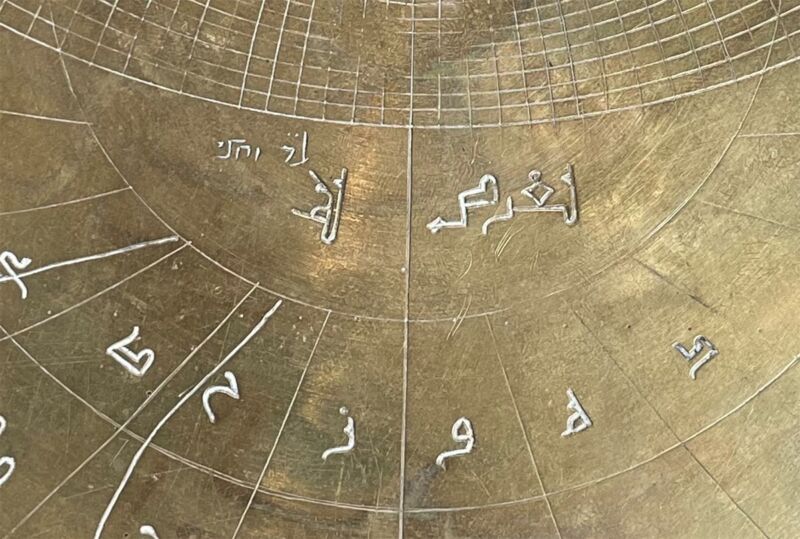
Federica Gigante
Cambridge College historian Federica Gigante is an skilled on Islamic astrolabes. So naturally she was intrigued when the Fondazione Museo Miniscalchi-Erizzo in Verona, Italy, uploaded a picture of simply such an astrolabe to its web site. The museum thought it may be a faux, however when Gigante visited to see the astrolabe firsthand, she realized it was not solely an genuine eleventh century instrument—one of many oldest but found—it had engravings in each Arabic and Hebrew.
“This isn’t simply an extremely uncommon object. It’s a strong report of scientific alternate between Arabs, Jews, and Christians over a whole lot of years,” Gigante said. “The Verona astrolabe underwent many modifications, additions, and variations because it modified arms. At the least three separate customers felt the necessity to add translations and corrections to this object, two utilizing Hebrew and one utilizing a Western language.” She described her findings in a new paper printed within the journal Nuncius.
As beforehand reported, astrolabes are literally very historical devices—presumably courting way back to the second century BCE—for figuring out the time and place of the celebs within the sky by measuring a celestial physique’s altitude above the horizon. Earlier than the emergence of the sextant, astrolabes had been mostly used for astronomical and astrological research, though additionally they proved helpful for navigation on land, in addition to for monitoring the seasons, tide tables, and time of day. The latter was particularly helpful for spiritual features, comparable to monitoring each day Islamic prayer occasions, the path of Mecca, or the feast of Ramadan, amongst others.
Navigating at sea on a pitching deck was a bit extra problematic until the waters had been calm. The event of a mariner’s astrolabe—a easy ring marked in levels for measuring celestial altitudes—helped clear up that downside. It was finally changed by the invention of the sextant within the 18th century, which was far more exact for seafaring navigation. Mariner’s astrolabes are among the many most prized artifacts recovered from shipwrecks; only 108 are presently cataloged worldwide. In 2019, researchers decided {that a} mariner’s astrolabe recovered from the wreck of certainly one of Portuguese explorer Vasco da Gama’s ships is now formally the oldest recognized such artifact. The so-called Sodré astrolabe was recovered from the wreck of the Esmeralda (a part of da Gama’s armada) off the coast of Oman in 2014, together with round 2,800 different artifacts.
An astrolabe is often comprised of a disk (mater) engraved with graduations to mark hours and/or arc levels. The mater holds another engraved flat plate (tympans) to symbolize azimuth and altitude at particular latitudes. Above these items is a rotating framework known as the rete that basically serves as a star map, with one rotation being equal to someday. An alidade hooked up to the again could possibly be rotated to assist the person take the altitude of a sighted star. Engravings on the backs of the astrolabes assorted however usually depicted totally different sorts of scales.
-
The Verona astrolabe, back and front views.
Federica Gigante -
Shut-up of the Verona astrolabe exhibiting inscribed Hebrew, Arabic, and Western Numerals
Federica Gigante -
Dedication and signature: “For Isḥāq […], the work of Yūnus”
Federica Gigante -
Federica Gigante inspecting the Verona astrolabe.
Federica Candelato
The Verona astrolabe is supposed for astronomical use, and whereas it has a mater, a rete, and two plates (certainly one of which is a later substitute), it’s lacking the alidade. It is also undated, in keeping with Gigante, however she was capable of estimate a possible date primarily based on the instrument’s design, building, and calligraphy. She concluded it was Andalusian, courting again to the eleventh century when the area was a Muslim-ruled space of Spain.
As an example, one facet of the unique plate bears an Arabic inscription “for the latitude of Cordoba, 38° 30′” and one other Arabic inscription on the opposite facet studying “for the latitude of Toledo, 40°.” The second plate (added at some later date) was for North African latitudes, so sooner or later, the astrolabe may need discovered its technique to Morocco or Egypt. There are engraved strains from Muslim prayers, indicating it was in all probability initially used for each day prayers.
There’s additionally a signature on the again in Arabic script: “for Isḥāq […]/the work of Yūnus.” Gigante believes this was added by a later proprietor. Because the two names translate to Isaac and Jonah, respectively, in English, it is potential {that a} later proprietor was an Arab-speaking member of a Sephardi Jewish group. Along with the Arabic script, Gigante seen later Hebrew inscriptions translating the Arabic names for sure astrological indicators, in step with the earliest surviving treatise in Hebrew on astrolabes, written by Abraham Ibn Ezra in Verona in 1146.
“These Hebrew additions and translations counsel that at a sure level the thing left Spain or North Africa and circulated amongst the Jewish diaspora group in Italy, the place Arabic was not understood, and Hebrew was used as an alternative,” said Gigante. “This object is Islamic, Jewish, and European, they will’t be separated.”
Nuncius, 2024. DOI: 10.1163/18253911-bja10095 (About DOIs).
